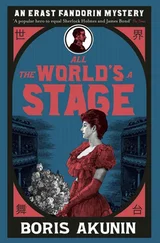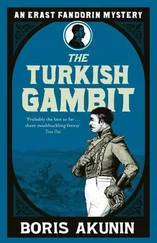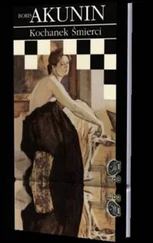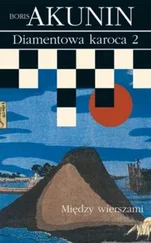An answer had also been found to the riddle of how the perpetrators had managed to place a mine on a tightly guarded target and explode it right under the wheels of the military train. At the point of the fracture, the experts had discovered scraps of leather from some unknown source and microscopic particles of dense laboratory glass. After racking their brains for a while, they offered their conclusion: a long, cylindrical leather case and a narrow spiral glass tube.
That was enough for Erast Petrovich to reconstruct a picture of what had happened.
The melinite charge had been placed in a leather package, something like a case for a clarinet or other narrow-bodied wind instrument. There had not been any hard casing at all – it would only have made the mine heavier and weakened the blast. The explosive used was chemical, with a retardant – the engineer had read about those. A glass tube holding fulminate of mercury is pierced by a needle, but the fulminate does not flow out immediately, it takes thirty seconds or a minute, depending on the length and shape of the tube.
No doubt remained: the bomb had been dropped from the express travelling directly in front of the special.
The situation by which the two trains were in dangerously close proximity to each other had been arranged by artifice, using the false telegram that was passed on by the telegraph clerk at Kolpino (who, naturally, had disappeared without a trace).
Fandorin racked his brains for a while over the question of exactly how the mine had been dropped. Through the window of a compartment? Hardly. The risk was too great that when the case hit the covering of the bridge, it would go flying off into the river. Then he guessed – through the flush aperture in the toilet. That was what the narrow case was for. Ah, if only that witness hadn’t interfered, with her comments about the suspicious dark-haired man! He should have acted as he had planned to do from the start: make a list of the passengers, and question them too. Even if he’d had to let them all go, he could have interrogated them again now – they would definitely have remembered a travelling musician, and it was quite probable that he wasn’t alone, but in a group …
Once the mystery of the disaster had been solved, Erast Petrovich had no time for wounded pride, for more compelling concerns came to light.
The engineer’s work in the Railway Gendarmerie (or, as Mylnikov called it, the ‘Randarmerie’) had already been going on for an entire year already, directed to a single goal: to protect the most vulnerable section in the anatomy of the ailing Russian dinosaur – its one major artery. The enterprising Japanese predator that had been attacking the wounded giant from all sides must realise sooner or later that he did not need to knock his opponent off its feet, it was enough simply to gnaw through the single major vessel of its blood supply – the Trans-Siberian main line. Left without ammunition, provisions and reinforcements, the Manchurian army would be doomed.
The Tezoimenitsky Bridge was no more than a test run. Traffic over it would be completely restored in two weeks, and meanwhile trains were making a detour via the Pskov-Starorusskoe branch, losing only a few hours. But if a similar blow were to be struck at any point beyond Samara, from where the main line extended as a single thread for eight thousand versts, it would bring traffic to a halt for at least a month. Linevich’s army would be left in a catastrophic position. And apart from that, what was to stop the Japanese from arranging one act of sabotage after another?
Of course, the Trans-Siberian was a new line, built using modern technology. And the last year had not been wasted – a decent system of security was up and running, and the Siberian bridges could in no way be compared with the Tezoimenitsky – you wouldn’t blow them up with ten pounds of melinite dumped through the outlet of a water closet. But the Japanese were shrewd, they would come up with something else. The worst thing had already happened – they had already launched their war on the railways. Just wait and see what would come next.
This thought (which was, unfortunately, quite incontrovertible) made Erast Petrovich feel afraid. But the engineer belonged to that breed of people in whom the response to fear is not paralysis or panic-stricken commotion, but the mobilisation of all their mental resources.
‘Melinite, melinite,’ Fandorin repeated thoughtfully as he strode around the office that he had taken on temporary loan from Danilov. He snapped the fingers of the hand he was holding behind his back, puffed on his cigar and stood at the window for a long time, screwing his eyes up against the bright May sky.
There could be no doubt that the Japanese would also use melinite for subsequent acts of sabotage. They had tested the explosive on the Tezoimenitsky Bridge and the results had been satisfactory.
Melinite was not produced in Russia, the explosive was deployed only in the arsenals of France and Japan, and the Japanese called it simose or, as distorted by the Russian newspapers, ‘ shimoza ’. It was simose that was given most of the credit for the victory of the Japanese fleet at Tsushima: shells packed with melinite had demonstrated far greater penetrative and explosive power than the Russian powder shells.
Melinite, or picric acid, was ideally suited for sabotage work: powerful, easy to combine with detonators of various kinds and also compact. But even so, to sabotage a large modern bridge would require a charge weighing several pood s. Where would the saboteurs get such a large amount of explosive and how would they convey it?
This was the key point – Erast Petrovich realised that straight away – but before he advanced along his primary line of search, he put certain precautions in place on his secondary one.
In case the melinite theory was mistaken and the enemy was intending to use ordinary dynamite or gun cotton, Fandorin gave instructions for a secret circular to be sent to all the military depots and arsenals, warning them of the danger. Of course, this piece of paper would not make the guards any more vigilant, but thieving quartermasters would be more afraid of selling explosive on the side, and that was precisely the way that such lethal materials usually found their way into the hands of Russia’s terrorist bombers.
Having taken this safety measure, Erast Petrovich concentrated on the routes for transporting melinite.
They would deliver it from abroad, and most likely from France (they couldn’t bring it all the way from Japan!).
You can’t ship a load of at least several pood s in a suitcase, thought Fandorin, twirling in his fingers a test tube of light yellow powder that he had acquired from an artillery laboratory. He raised it to his face and absentmindedly drew the sharp smell in through his nose – the same ‘fatal aroma of shimoza ’ that the Russian war correspondents were so fond of mentioning.
‘Well now, p-perhaps,’ Erast Petrovich murmured.
He quickly got up, ordered his carriage to be brought round, and a quarter of an hour later he was already on Maly Gnezdnikovsky Lane, at the Police Telegraph Office. There he dictated a telegram that set the operator, who had seen all sorts of things in his time, blinking rapidly.
The fifth syllable, consisting almost completely of face-to-face conversations
On the morning of 25 May, Countess Bovada’s boarder received news of the arrival of the Delivery and the Shipment on the same day, as had been planned. The organisation was working with the precision of a chronometer.
The Delivery consisted of four one-and-a-half- pood sacks of maize flour, sent from Lyons for the Moscow bakery ‘Werner and Pfleiderer’. The consignment was awaiting the consignee at the Moscow Freight Station depot on the Brest line. It was all very simple: turn up, show the receipt and sign. The sacks were extremely durable – jute, waterproof. If an overly meticulous gendarme or railway thief poked a hole in one to try it, the yellow, coarse-grained powder that poured out would pass very well for maize flour in wheat-and-rye-eating Russia.
Читать дальше









